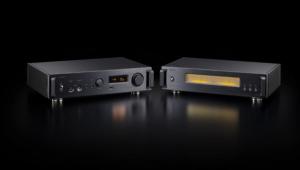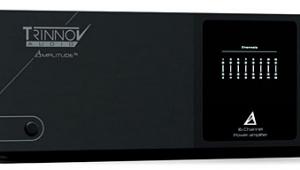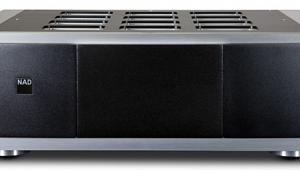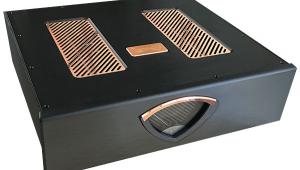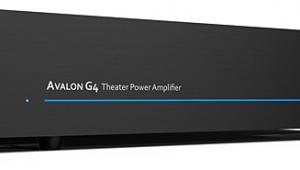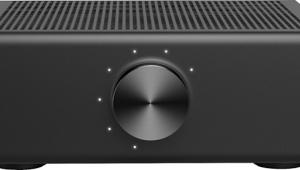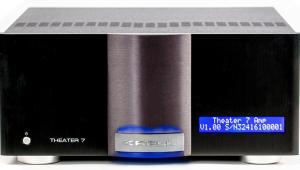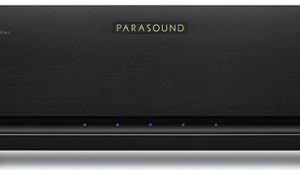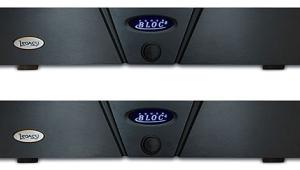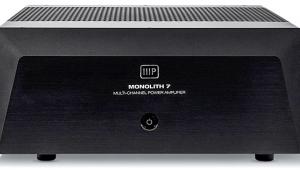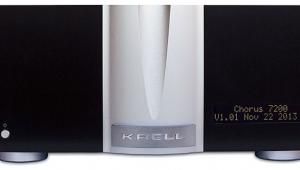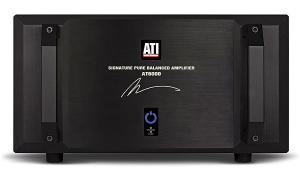Parasound Halo C 2 & Halo A 51 surround processor & 5-channel power amplifier

This dreamscape came back to me at a dinner with friends a few weeks before last January's Consumer Electronics Show. One guest grumbled that "technology is getting more complicated, not easier." All present agreed. Our host, a brilliant pediatrician and epidemiologist, sheepishly passed around his well-thumbed copy of Digital Photography for Dummies, to nodding approval. Progress marches on, leaving hapless consumers in its wake.
HALO C 2 SURROUND PROCESSOR
Parasound's international design team must have spent plenty of time thinking about this modern problem. Five years in development, the company's Halo C 2 surround processor is a brilliantly executed piece of technology, superficially simple and deeply complex, that lends itself with equal grace to the nave movie fan, jaded audiophile, or veteran home theater enthusiast. Two minutes of instruction are sufficient to familiarize anyone with its basic operation, but below its surface lurks an amazing assortment of tools.
House of Blue Lights
The C 2's sleek, uncluttered front panel offers only a few blue-illuminated buttons, a blue alphanumeric display, and one large knob that serves as source or surround-mode selector and volume control, depending on which function has been chosen before touching the knob. Volume is the default function. When a function (e.g., Source or Mode) has been chosen, you have five seconds to change it before the large knob reverts to a volume control. Once you've stepped through the choices and arrived at the one you want, it remains in effect until you change it again.
The buttons are arranged for easy one-handed operation, but using the included multifunction MX-700 remote (OEM'd from Universal Remote Control) is vastly easier. Some of the C 2's functions are actually hard to get to unless you use the remote. The remote's display, like the display on the C 2, can be customized using a laptop computer and software downloadable from Parasound's website. The remote can learn commands from other remotes and can be programmed with macros to launch commands in a specific order with a minimum amount of button-pushing.
The C 2's rear panel is as crowded as its front panel is clean. Every square inch is occupied with input and output connectors, including: one pair of "purist" balanced audio inputs (which can be set up to bypass all DSP so it never even enters the digital domain); four each coaxial and optical digital inputs; five balanced outputs; multiple component-video, S-video, and composite-video inputs; 7.1-channel analog inputs and outputs; two additional outputs for things like subwoofers and tactile transducers ("floorshaker," "butt-kicker," or similar device); Zone B outputs; 2 two digital outputs (one coax and one optical); and four channels that can be programmed to deliver almost any combination of signals available in any of the other channels. There are three 12V trigger outs, a serial port for connection to a laptop computer, and an expansion bay for technologies to come.

From the rear, the C 2 looks as if it would be right at home in any digital-video production studio, and its specifications support that impression. The C 2's component-video inputs are claimed to be capable of zero-loss switching at 1080p, the highest-level HDTV signal. I could discern no difference comparing component video looped through the C 2 vs. a direct feed. S-video output from it looked excellent also.
One drawback in the C 2's video design is that it doesn't convert a composite-video signal (as from a camcorder or VCR) to S-video or component, a feature now available on some less-expensive home theater receivers. The Zone B output, which is intended to feed whole-house distributed A/V systems or a second room, is strictly a composite-video/2-channel-audio affair. S-video would be a welcome addition there, given that low-loss S-video cables can carry signals to the farthest reaches of the largest homes.
Setup
I first unpacked the Halo and installed it as a simple 2-channel preamp, just to get a clue about how it sounded. The preamp it was replacing, the Tom Evans Audio Designs Vibe, is easily one of the most transparent devices in the high-fidelity realm. I was prepared for the C 2 to sound good—but not as good as it did, which was superb. It got within spitting distance of the Vibe in every respect: dynamics, bass extension, detail, air, stability of image. Add in everything it does that the Vibe doesn't and can't do—video switching, D/A conversion, every imaginable variety of surround processing, complete control over every aspect of speaker performance and input characteristic, 7.5-channel capability, auto calibration, remote control, and second-zone output completely independent from the primary one—and for only $4000 retail, the C 2 looked like a serious bargain right out of the box.
Speaker setup was a cinch. The supplied calibration microphone, with about 30 feet of cable, plugs into a jack on the C 2's front panel. I mounted it on a boom mike stand, pointing it straight up approximately where my head would be in my usual sitting position, and threw a couple of pillows on the sofa to stand in for me and Robyn. (According to an antique acoustics textbook I had, a pillow has about the same acoustic absorption as a human body.)
Using the remote control or the front panel, you tell the C 2 how many speakers—two, three, five, or seven—are in the system, assign the speakers as Large (full-range) or Small (limited bass), and whether or not you have a subwoofer or two. Then you engage the auto-calibration (Test) mode. In a series of three passes, the C 2 determines each speaker's distance from the mike, establishes the necessary timing cues, and sets the levels to 0dB THX reference level, "equivalent to a sound pressure level of 75dB," as the C 2's manual explains it.
The manual cautions that subwoofers are especially difficult to auto-calibrate, and suggests that if the C 2 can't do it properly after three attempts, you should enter the distance to the sub manually. In my case, the C 2 thought my James 10S sub, which stands right next to the right front tower, was 49 feet away. At that setting, the low bass was incredibly mushy due to phase cancellation between the sub and the front L/R pair. Entering the correct distance, 14 feet, into the calibration memory cleared this up immediately. Voil! Instant deep, tight bass.
The C 2 allows changes to any individual setting in the calibration memory without altering any of the others. Even though the surrounds' levels were technically correct at 0dB THX, they sounded too prominent in the multichannel modes. Backing them off by 3dB brought everything into balance—full, enveloping surround fields without a nagging awareness of speakers above and behind me. As with video setups, the technically correct calibration is simply a good place to start. For final adjustments, always trust your eyes and ears.
The C 2 conveniently lets you tweak and memorize bass and treble adjustments or every input and set input levels so that you don't blow yourself out of the water with an input that's too loud. Another thoughtful, civilized feature is that when either the primary zone or Zone B is turned off, the volume level is muted when you turn it back on.
You do need a video display for all this setup and tweaking. The C 2's more-expensive sibling, the C 1, incorporates a 5-inch LCD screen in its front panel, like similar products from Bel Canto Designs and Mark Levinson. The C 1 also costs $2000 more than the C 2, and it includes one more set of component-video inputs and a more sophisticated power-supply filter. Otherwise, the two are identical and, according to Parasound, offer the same sonic performance.
In my case, the C 1's front-panel video display wouldn't help, because the electronics are in a separate room from the home theater. (I use a Niles remote sensor and wide-area IR flasher to control everything.) But the video feedback is essential. Here's how to save $2000 by not having to buy a C 1 if you want a convenient video monitor but can't always use your main video display, or don't want to: Best Buy sells a 5-inch black-and-white TV, the Curtis International RT 068, for $30. It has a miniplug video input on the back. Run the C 2's OSD (onscreen display) composite output to it and you've got a great display. The little Curtis TV can sit on your equipment rack or (as in my house) the coffee table so you can see what you're doing with the remote control without the annoyance of having to display graphic information on your 8-foot screen.
- Log in or register to post comments
